Modes of transport in Gabon include rail, road, water, and air. The one rail link, the Trans-Gabon Railway, connects the port of Owendo with the inland town of Franceville. Most but not all of the country is connected to the road network, much of which is unpaved, and which centres on seven "national routes" identified as N1 to N7. The largest seaports are Port-Gentil and the newer Owendo, and 1,600 km of inland waterways are navigable. There are three international airports, eight other paved airports, and over 40 with unpaved runways. Nearly 300 km of pipelines carry petroleum products, mainly crude oil.

The Orinoco is one of the longest rivers in South America at 2,250 kilometres (1,400 mi). Its drainage basin, sometimes known as the Orinoquia, covers 880,000 km2 (340,000 sq mi), with 76.3 percent of it in Venezuela and the remainder in Colombia. It is the fourth largest river in the world by discharge volume of water. The Orinoco River and its tributaries are the major transportation system for eastern and interior Venezuela and the Llanos of Colombia. The environment and wildlife in the Orinoco's basin are extremely diverse.
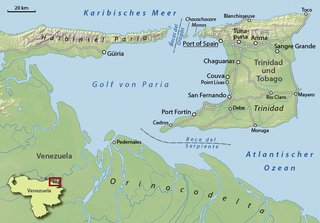
The Gulf of Paria is a 7,800 km2 (3,000 sq mi) shallow semi-enclosed inland sea located between the island of Trinidad and the east coast of Venezuela. It separates the two countries by as little as 15 km at its narrowest and 120 km at its widest points. The tides within the Gulf are semi-diurnal in nature with a range of approximately 1m. The Gulf of Paria is considered to be one of the best natural harbors on the Atlantic coast of the Americas. The jurisdiction of the Gulf of Paria is split between Trinidad and Tobago and Venezuela with Trinidad and Tobago having control over approximately 2,940 km2 (1,140 sq mi)(37.7%) and Venezuela the remainder(62.3%).

Ciudad Guayana is a city in Bolívar State, Venezuela. It stretches 40 kilometers along the south bank of the Orinoco river, at the point where it is joined by its main tributary, the Caroní river. The Caroni crosses the city south-north and divides it on its two main halves: the old town of San Félix in the east, and the new town of Puerto Ordaz in the west. The city was officially founded in 1961 by the unification of this two former settlements, but the history of San Félix goes back to its foundation in 1724. Within the city limits are located the site of Cachamay Falls and Llovizna Falls. There are three bridges across the Caroni and the second crossing over the Orinoco, the Orinoquia Bridge, was inaugurated in the city in 2006. With approximately one million people, it is Venezuela's fastest-growing city due to its important iron, steel, aluminium and hydroelectric industries. Ciudad Guayana is one of Venezuela's five most important ports, since most goods produced in the industry-rich Bolívar state are shipped through it, as ocean-going vessels can sail to it from the Atlantic Ocean up the Orinoco river.

Macuro, a town in Venezuela, located a few miles from Bocas del Dragón, is a small fishing town overlooking a peaceful bay on the south-west side of the Paria peninsula, in Sucre state, Venezuela
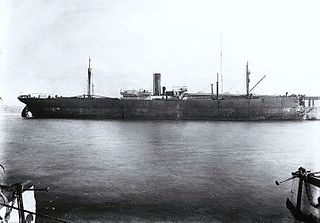
Storstad was a steam cargo ship built in 1910 by Armstrong, Whitworth & Co Ltd of Newcastle for A. F. Klaveness & Co of Sandefjord. The ship was primarily employed as an ore and coal carrier doing tramp trade during her career. She is best known for accidentally ramming and sinking the ocean liner RMS Empress of Ireland in 1914, killing over 1,000 people.

Navios Maritime Holdings Inc. (“Navios”) is a global, vertically integrated seaborne shipping and logistics company focused on the transport and transshipment of drybulk commodities including iron ore, coal and grain. Navios was created in 1954 by US Steel to transport iron ore to the US and Europe. Since then, Navios has diversified geographically and expanded the scope of its business activities such that Navios currently controls 49 vessels totaling approximately 5.1 million deadweight tons.
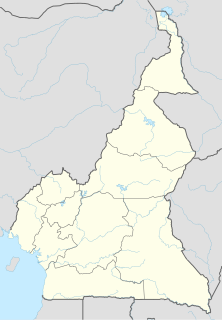
Lolabé is a small coastal town in Cameroon. It lies on the Atlantic Ocean, about halfway between Kribi and the border with Equatorial Guinea.
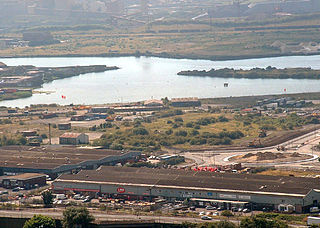
The port of Port Talbot is located on the River Afan estuary next to Port Talbot Steelworks in the industrial town of Port Talbot, South Wales. The whole basin complex covers about 500 acres (2.0 km2), consisting of: an inner set of floating docks, developed from 1834 onwards; and an outer tidal basin, completed in 1970. Owned and operated by Associated British Ports, the port of Port Talbot has the deepest berthing facilities in the Severn estuary and is one of only a few harbours in the UK capable of handling Capesize vessels of up to 170,000 tonnes deadweight (DWT), mostly for the import of iron ore and coal for use by nearby Port Talbot Steelworks.
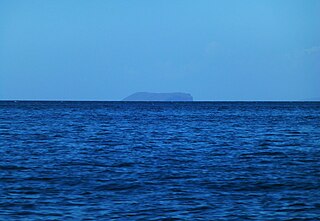
Patos Island is a small uninhabited island in the northwestern Gulf of Paria. The island is a part of the Dependencias Federales of Venezuela.

Altamira is a town in the Puerto Plata Province of the Dominican Republic.
In March 2010, the Freeport of Monrovia became ISPS Compliant and moved from Security Level 2 to Security Level 1 in July 2010. The Freeport of Monrovia awarded Operations Contract to APM Terminal to handle port operations, which includes container handling, cargo handling, and marine.

Siderúrgica de Orinoco C.A. (Sidor) is the largest Venezuelan steel corporation. The company is situated in an industrial zone in Ciudad Guayana, Bolívar State, near the Orinoco River.

Lucky Bay is a locality in the District Council of Franklin Harbour, on the Spencer Gulf coast of Eyre Peninsula in South Australia. It is a terminus for SeaSA's Spencer Gulf passenger ferry and a transshipping port for grain export operated by T-Ports. Lucky Bay is located immediately north-east of the Franklin Harbour wetlands. Its adjacent waters lie within the outer boundary of the Franklin Harbor Marine Park. A ferry service crossing Spencer Gulf from Lucky Bay to Wallaroo commenced in 2006, and the dirt road connecting Lucky Bay with the Lincoln Highway was sealed in 2008.

Valemax ships are a fleet of very large ore carriers (VLOC) owned or chartered by the Brazilian mining company Vale S.A. to carry iron ore from Brazil to European and Asian ports. With a capacity ranging from 380,000 to 400,000 tons deadweight, the vessels meet the Chinamax standard of ship measurements for limits on draft and beam. Valemax ships are the largest bulk carriers ever constructed, when measuring deadweight tonnage or length overall, and are amongst the longest ships of any type currently in service.

MV Vale Rio de Janeiro, owned by the Brazilian mining company Vale, is one of the world's largest very large ore carriers and a sister ship of Vale Brasil. Designed to carry iron ore from Brazil to Asia along the Cape route around South Africa, she is the second of seven 400,000-tonne very large ore carriers (VLOC) ordered by Vale from Daewoo Shipbuilding & Marine Engineering in South Korea and twelve from Jiangsu Rongsheng Heavy Industries in China. While close to the specifications of Chinamax, these ships are generally referred to as Valemax vessels by Vale.

Port Hedland is one of the largest iron ore loading ports in the world and the largest in Australia. In 2011 it had the largest bulk cargo throughput in Australia. With the neighboring ports of Port Walcott and Dampier, Port Hedland is one of three major iron ore exporting ports in the Pilbara region of Western Australia,
Roy A. Jodrey was a bulk carrier owned by Algoma Central Railway. The ship was launched and entered service in 1965, one of four ships constructed for the company to access ports on the Great Lakes and Saint Lawrence Seaway too small for use by the larger lake freighters. On 20 November 1974, Roy A. Jodrey struck Pullman Shoal in the St. Lawrence River in Alexandria Bay, New York. The vessel made it to the United States Coast Guard Station at Wellesley Island and tied up. At 03:00, the bulk carrier sank in 77 metres (254 ft) of water, with its entire crew reaching safety. No attempt to salvage the ship was made, but Algoma did try to salvage the vessel's cargo of iron ore, which led to the death of a diver. Roy A. Jodrey became a technical scuba diving site, whose difficulty has led to the deaths of a some of those who have attempted it.

Themis was a steam cargo ship built in 1911 by the William Doxford & Sons of Pallion for the Wabanas Dampskibskompani, a subsidiary of Nova Scotia Steel & Coal Company and managed by Wilhelm Wilhelmsen. She was named after Themis, Titaness of divine law and order.















